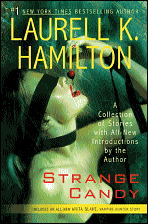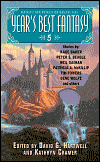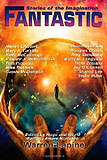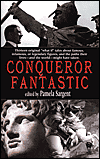
Strange Candy, by Laurell K. Hamilton
Book Review by Mike Swope
Have you read this book?
I honestly do not know much about Laurell K. Hamilton's books. I read a
couple in the Anita Blake series a few years ago. I forget where I got
them. They're hardback, which I don't normally buy due to cost. So I may
have gotten them from the Book of the Month club or as Christmas or
birthday gifts. At any rate, I enjoyed and remembered them.
So when I stumbled across Laurell's Strange Candy, a collection of short stories, my curiosity was piqued just by the author's name and the fact that they were short stories. The couple of novels noted above left an impression in my mind. So I picked up Strange Candy, read through its pages a few minutes, put it back, came back to it again, looked at the table of contents, noticed the introductions, read a few more pages, then took it home. I paid for it, of course.
I am not disappointed.
I have an MFA in creative writing in short fiction. So I have a love for short fiction. What made me decide to purchase this book? Not the stories! Instead, I found that the short introductions to each story interested me as a writer. So I bought Strange Candy for a strange reason: its short single paragraph intros to each story as commentary. Nothing particularly life-altering here, just interesting personally. It is probably good that I'm not too familiar with Laurell's highly successful Anita Blake novels. My ignorance allows me to approach these bits of Strange Candy like, well, a stranger.
The stories themselves are indeed Strange Candy. They're short, sweet, and eclectic. Like a small bowl of hard candy. In here are two stories featuring Anita Blake, "Those Who Seek Forgiveness" and "The Girl Who Was Infatuated with Death." The first opens the book; the latter closes the book. The first is Anita Blake at her meekest, simply a raiser of the dead; the latter the dark, torn, lusty, vamp hunter Anita Blake the reading audience loves. With good reason. The latter story is the second most engaging in this collection. It is also the newest story, perhaps, since it was commissioned by Laurell's publisher for a collection of short stories. Alone, however, both stories are good reads, set in an unusual world with an interesting problem: a woman who seeks forgiveness from her recently-deceased husband so badly it kills her; and an underage teen girl about to lose her leg to disease wishes to become an undead vampire to save it. Incidentally, in the brief introduction to the story, Laurell tells us that "Those Who Seek Forgiveness" is the first time that Anita "ever walked on paper."
Sandwiched between these two Anita Blake stories are twelve other stories set in no less interesting worlds with no less interesting situations. The lightest of the stories, "A Lust of Cupids," is second in the collection. In this story, the cute, lovable, blond cherubs of our world are twisted into feared, mind-clouding mercenaries of an alternate universe, sometimes hunting in a lust (a group like a gaggle!) if the price is right. In this case, hunting for love in all the wrong places, as far as the unmarried, thirty-plus year old protagonist of this tale is concerned. This time, though, she can't escape the cunning cupids, and goes down hard, along with her new friend. This story, though light in comparison, is signature Hamilton fiction with a pinch of sugar.
Laurell herself admits that she doesn't like science fiction much. "Hardware-oriented science doesn't interest the writer in me," she notes in the introduction to "Here Be Dragons." Though Laurell defines this story as science fiction, it is a loose definition. In "Here Be Dragons," a masterpiece IMHO, instead of hard science and technology, there is the ability to enter the dreams of others, usually for nefarious purpose. This haunting story is built around this dark, misunderstood natural ability. "Some people are just born evil," Hamilton writes in the opening sentence, then it's a slow, torturous, juicy thrill ride to the end. Jasmine, the protagonist, is a powerful dream therapist, rehabilitating the most vile, disturbed people, i.e. serial killers. She loves her work. Perhaps too much. In this story, Jasmine encounters an evil little girl perhaps more powerful than she. This little girl, Lisbeth, goes to work torturing people in their dreams, something like a serial killer. Perhaps this little girl is worse than a serial killer because her victims awaken every morning, and she can torture them night after night after night until her darkest heart's content! Jasmine, rather than allow authorities to kill Lisbeth, shows Lisbeth how to satiate her desire and lust for terror in the guise of therapy. At story's end, I feel that Jasmine understands Lisbeth's needs perhaps too well. It is the interesting interplay of characters and the revelation about Jasmine's character in particular that make this story the best in the collection. Most readers may not understand the revelation about Jasmine's character at first, but the best readers will shudder when they understand what has been revealed. I guarantee it!
Besides the two stories featuring Anita Blake, a third story in this collection is set in that same world without the familiar signature characters. "Selling Houses" is an extrapolation of Laurell asking the question: "What are people with less dangerous jobs doing in Anita's world now that vampires are legally alive? How has it changed other jobs? For instance, real estate...." In this story, Abbie is the goto psychic real estate agent, if your house is hard to sell because murderers had lived in it, or its occupants have been slaughtered in it, for example. The house she has to sell is an example of the latter, still haunted by a little boy named Brian. This house, it turns out, might be just the perfect home for a small family of vampires. By law, they're people, too, just like Abbie or any of her friends. And they seem nice enough, and even have reflections.
One of Laurell's strengths is a habit "of taking the fantastic and dropping it into the middle of the real," as she confesses in the introduction to "A Scarcity of Lake Monsters." This story comes from wondering about fabled monsters and how we might deal with them if they were indeed real like any other animal. Uncharacteristically cliched, however, "A Scarcity of Lake Monsters" is structured like a trite plot from a children's movie: the misunderstood monster is friendly, killed by hunters despite the caregivers' best intentions, and a baby monster is happily discovered amidst the tragedy. I am surprised that this story is included in this collection, a stray Sonic peppermint mixed into the candy dish. This story is perhaps the weakest in this collection.
"The Edge of the Sea" is another example of the fantastic in a recognizably real world. In this story, Adria awakes in her small house by the sea to find her roommate missing, and in her search, witnesses the impossible: the final moments of her roommate's murder. Of course, no one believes Adria that her roommate was murdered by a merman-like creature with a song like the mythic sirens who coax sailors to their deaths, not even Adria. He returns to seduce Adria, too, but Adria is prepared and shoots him to death. Police find blood on the beach, but no body. Not a particularly surprising plot, but better than "A Scarcity of Lake Monsters."
The theme of dropping the fantastic into the middle of the real world is better expressed in other stories in this collection. The better stories I've already mentioned, of course. "A Clean Sweep," is another example of this recurring theme. This story turns Captain Housework, a superhero without dirty supervillains to battle any more, into a bitter murderer who leaves 19 perfectly cleaned and polished skeletons in a house that has never been so clean. Though the shortest story in the book, it is a clever, entertaining gem with a sinister end. It reminds me of some of the stories of my friend, C. Dennis Moore (www.cdennismoore.com).
The remaining 6 stories in this collection clearly belong to the fantasy genre. They feature wizards, devils, dragons, swords, magic and the like. Though I'm no fan of stories of the fantasy genre, these stories yet engaged me once I had begun to read them. Not only are Laurell's best stories about interesting characters in interesting circumstances in interesting worlds, they also have complex relationships and surprises throughout. These elements alone keep most readers engaged. Even those readers like me with predisposition to dislike them.
"Geese" and "House of Wizards" open with interesting situations that Laurell deftly develops into interesting stories. "Geese" came to Laurell by pure inspiration one evening while watching geese settle down for the night at sunset in Missouri, an experience that has not happened since. "It was amazing," Laurell writes in the introduction to the story, "this rush of ideas, character, a whole story from beginning to end." In "Geese," Alatir has shape-shifted and hidden herself among the geese for several years, to combat a geas spell placed upon her by a powerful sorcerer to amuse himself. Now, soldiers bearing that same sorcerer's livery, have come to the lake where she now lives and now attack the children of the nearby mill, to steal them for the sorcerer's desires. Alatir, no longer a child but a young woman, shape-shifts back into human form to save the children, and faces the sorcerer for the last time, even if it means her death.
In "House of Wizards," Rudelle, a practical woman, a Calthuian farmer's daughter who knows nothing about magic, has married Trevelyn Herbmage and into his family, an extended family of wizards, and has just come to Astrantha, a land of wizards. She is about to be introduced to Trevelyn's parents, two sisters, and brother. Hence the title, "House of Wizards." In Astrantha, were she not married, she would be a peasant, a non-person, and could not even vote because she has no magic. Is Rudelle turned into a frog, or worse, by Trevelyn's parents? Killed by his ten-year-old brother? You'll have to read the story to discover the powerful magic Rudelle wields in this house of wizards.
The last four stories are set in a world which may be familiar to Laurell Hamilton's readers, that of her first novel, Nightseer. Marion Zimmer Bradley (surely you recognize that name!) rejected "A Token for Celandine" as a "pastiche of Tolkien, and elves should really be left to him," Laurell tells us. Laurell of course disagreed and sold the story the next time out. In "A Token for Celandine," Celandine, a white healer and daughter of the King of Celosia, and Bevhinn, a Varellian earth-witch paid by her father to protect her, quest for a mysterious token that would cleanse Celandine's soul of the stain of black healing. Prophecies have said that the token will be found inside a demon. On their quest, Celandine and Bevhinn find themselves facing off against a powerful black healer who possesses the token. They have only one chance to kill this black healer and steal away with the token. Can you guess the twist of fate that awaits them at story's end? I bet not.
"Winterkill" introduces us to more characters in the world of Nightseer. In this story, Jessamine Swordwitch, an earth-witch like Bevhinn in "A Token for Celandine" who only kills wizards, and her swordmate and lover, Gregoor, have been given the mission to kill Cytherea of Cheladon, aka Cytherea the Mad, the mother of the young wizard who destroyed Jessamine's village many years before. As fate would have it, Jessamine in return killed the young wizard who had killed everyone in her village -- he was the first wizard she ever killed -- and Cytherea, his mother, now seeks his killer. So the two are destined to meet. A pair of cheap, simple curses help decide the battle for the heroes. At Cytherea's death, the magic she has stolen from the earth and earth-witches is released and returned. One finds some parallels between Jessamine, who kills only wizards, and Anita Blake, who only kills vampires.
The remaining two stories also take place in the magical realm of Nightseer. "Stealing Souls" is the first story Laurell ever sold, and marks the first appearance of Sidra Ironfist, mercenary thief, and Leech, her enchanted, humming, blood-feeding short sword, both interesting, enduring characters. In "Stealing Souls," Sidra and her bard, Milon Songsmith, are on a quest to steal back the souls of Sidra's two younger sisters, who were rumored to have been stolen and imprisoned by a wizard to make him more powerful. With each battle, Sidra must make a blood contract with Leech for his aid. Sometimes this means feeding him herself; other times his price is higher, the blood of others. Demons frequently figure in the stories set in the Nightseer world; "Stealing Souls" is no different. Sidra and Milon track the wizard to a demon-enchanted, demon-protected, booby trapped tower. In the end, Sidra, Leech and Milon rescue the souls of her sisters.
Sidra and Leech also appear in "The Curse-Maker." In this story, we find Milon Songsmith succumbing to a death curse; it is only a matter of hours before he is dead. So Sidra, armed with her blood-feeding short sword Leech, sets out to find the curse-maker who cast this illegal, uncivilized spell on her friend and force him to undo what he has done. In this story, Laurell gives Leech a greater depth of character, embodying him with personality. When Leech is first unsheathed, he pouts that Gannon, the sorcerer accompanying Sidra on this quest, does not fear him. "Not afraid...No fun," he says, and immediately looks and calls almost playfully for Milon, who does fear him, and even hums one of Milon's own tunes to himself, bawdy version of course. We also learn that Leech is a blood blade, an evil sword, who has eventually turned on everyone who has wielded it. Leech is the standout character in "The Curse-Maker." Of course, it goes without saying that Milon is saved by his friends. With a little help from Leech.
Together, these fourteen stories span Laurell's first sale to her most recent. Bravely, Laurell has also included perhaps her weakest published story. Boldly, she has also provided brief commentary on each and every story in the collection. This commentary does not enhance the stories, but it offers readers the unique opportunity to glance into the writer's mind and method. This experience, like the stories, is unusual enough to be called Strange Candy. If you're an aspiring writer, you'll find these stories and their commentary perhaps even sweeter and more satisfying than the average reader.
So when I stumbled across Laurell's Strange Candy, a collection of short stories, my curiosity was piqued just by the author's name and the fact that they were short stories. The couple of novels noted above left an impression in my mind. So I picked up Strange Candy, read through its pages a few minutes, put it back, came back to it again, looked at the table of contents, noticed the introductions, read a few more pages, then took it home. I paid for it, of course.
I am not disappointed.
I have an MFA in creative writing in short fiction. So I have a love for short fiction. What made me decide to purchase this book? Not the stories! Instead, I found that the short introductions to each story interested me as a writer. So I bought Strange Candy for a strange reason: its short single paragraph intros to each story as commentary. Nothing particularly life-altering here, just interesting personally. It is probably good that I'm not too familiar with Laurell's highly successful Anita Blake novels. My ignorance allows me to approach these bits of Strange Candy like, well, a stranger.
The stories themselves are indeed Strange Candy. They're short, sweet, and eclectic. Like a small bowl of hard candy. In here are two stories featuring Anita Blake, "Those Who Seek Forgiveness" and "The Girl Who Was Infatuated with Death." The first opens the book; the latter closes the book. The first is Anita Blake at her meekest, simply a raiser of the dead; the latter the dark, torn, lusty, vamp hunter Anita Blake the reading audience loves. With good reason. The latter story is the second most engaging in this collection. It is also the newest story, perhaps, since it was commissioned by Laurell's publisher for a collection of short stories. Alone, however, both stories are good reads, set in an unusual world with an interesting problem: a woman who seeks forgiveness from her recently-deceased husband so badly it kills her; and an underage teen girl about to lose her leg to disease wishes to become an undead vampire to save it. Incidentally, in the brief introduction to the story, Laurell tells us that "Those Who Seek Forgiveness" is the first time that Anita "ever walked on paper."
Sandwiched between these two Anita Blake stories are twelve other stories set in no less interesting worlds with no less interesting situations. The lightest of the stories, "A Lust of Cupids," is second in the collection. In this story, the cute, lovable, blond cherubs of our world are twisted into feared, mind-clouding mercenaries of an alternate universe, sometimes hunting in a lust (a group like a gaggle!) if the price is right. In this case, hunting for love in all the wrong places, as far as the unmarried, thirty-plus year old protagonist of this tale is concerned. This time, though, she can't escape the cunning cupids, and goes down hard, along with her new friend. This story, though light in comparison, is signature Hamilton fiction with a pinch of sugar.
Laurell herself admits that she doesn't like science fiction much. "Hardware-oriented science doesn't interest the writer in me," she notes in the introduction to "Here Be Dragons." Though Laurell defines this story as science fiction, it is a loose definition. In "Here Be Dragons," a masterpiece IMHO, instead of hard science and technology, there is the ability to enter the dreams of others, usually for nefarious purpose. This haunting story is built around this dark, misunderstood natural ability. "Some people are just born evil," Hamilton writes in the opening sentence, then it's a slow, torturous, juicy thrill ride to the end. Jasmine, the protagonist, is a powerful dream therapist, rehabilitating the most vile, disturbed people, i.e. serial killers. She loves her work. Perhaps too much. In this story, Jasmine encounters an evil little girl perhaps more powerful than she. This little girl, Lisbeth, goes to work torturing people in their dreams, something like a serial killer. Perhaps this little girl is worse than a serial killer because her victims awaken every morning, and she can torture them night after night after night until her darkest heart's content! Jasmine, rather than allow authorities to kill Lisbeth, shows Lisbeth how to satiate her desire and lust for terror in the guise of therapy. At story's end, I feel that Jasmine understands Lisbeth's needs perhaps too well. It is the interesting interplay of characters and the revelation about Jasmine's character in particular that make this story the best in the collection. Most readers may not understand the revelation about Jasmine's character at first, but the best readers will shudder when they understand what has been revealed. I guarantee it!
Besides the two stories featuring Anita Blake, a third story in this collection is set in that same world without the familiar signature characters. "Selling Houses" is an extrapolation of Laurell asking the question: "What are people with less dangerous jobs doing in Anita's world now that vampires are legally alive? How has it changed other jobs? For instance, real estate...." In this story, Abbie is the goto psychic real estate agent, if your house is hard to sell because murderers had lived in it, or its occupants have been slaughtered in it, for example. The house she has to sell is an example of the latter, still haunted by a little boy named Brian. This house, it turns out, might be just the perfect home for a small family of vampires. By law, they're people, too, just like Abbie or any of her friends. And they seem nice enough, and even have reflections.
One of Laurell's strengths is a habit "of taking the fantastic and dropping it into the middle of the real," as she confesses in the introduction to "A Scarcity of Lake Monsters." This story comes from wondering about fabled monsters and how we might deal with them if they were indeed real like any other animal. Uncharacteristically cliched, however, "A Scarcity of Lake Monsters" is structured like a trite plot from a children's movie: the misunderstood monster is friendly, killed by hunters despite the caregivers' best intentions, and a baby monster is happily discovered amidst the tragedy. I am surprised that this story is included in this collection, a stray Sonic peppermint mixed into the candy dish. This story is perhaps the weakest in this collection.
"The Edge of the Sea" is another example of the fantastic in a recognizably real world. In this story, Adria awakes in her small house by the sea to find her roommate missing, and in her search, witnesses the impossible: the final moments of her roommate's murder. Of course, no one believes Adria that her roommate was murdered by a merman-like creature with a song like the mythic sirens who coax sailors to their deaths, not even Adria. He returns to seduce Adria, too, but Adria is prepared and shoots him to death. Police find blood on the beach, but no body. Not a particularly surprising plot, but better than "A Scarcity of Lake Monsters."
The theme of dropping the fantastic into the middle of the real world is better expressed in other stories in this collection. The better stories I've already mentioned, of course. "A Clean Sweep," is another example of this recurring theme. This story turns Captain Housework, a superhero without dirty supervillains to battle any more, into a bitter murderer who leaves 19 perfectly cleaned and polished skeletons in a house that has never been so clean. Though the shortest story in the book, it is a clever, entertaining gem with a sinister end. It reminds me of some of the stories of my friend, C. Dennis Moore (www.cdennismoore.com).
The remaining 6 stories in this collection clearly belong to the fantasy genre. They feature wizards, devils, dragons, swords, magic and the like. Though I'm no fan of stories of the fantasy genre, these stories yet engaged me once I had begun to read them. Not only are Laurell's best stories about interesting characters in interesting circumstances in interesting worlds, they also have complex relationships and surprises throughout. These elements alone keep most readers engaged. Even those readers like me with predisposition to dislike them.
"Geese" and "House of Wizards" open with interesting situations that Laurell deftly develops into interesting stories. "Geese" came to Laurell by pure inspiration one evening while watching geese settle down for the night at sunset in Missouri, an experience that has not happened since. "It was amazing," Laurell writes in the introduction to the story, "this rush of ideas, character, a whole story from beginning to end." In "Geese," Alatir has shape-shifted and hidden herself among the geese for several years, to combat a geas spell placed upon her by a powerful sorcerer to amuse himself. Now, soldiers bearing that same sorcerer's livery, have come to the lake where she now lives and now attack the children of the nearby mill, to steal them for the sorcerer's desires. Alatir, no longer a child but a young woman, shape-shifts back into human form to save the children, and faces the sorcerer for the last time, even if it means her death.
In "House of Wizards," Rudelle, a practical woman, a Calthuian farmer's daughter who knows nothing about magic, has married Trevelyn Herbmage and into his family, an extended family of wizards, and has just come to Astrantha, a land of wizards. She is about to be introduced to Trevelyn's parents, two sisters, and brother. Hence the title, "House of Wizards." In Astrantha, were she not married, she would be a peasant, a non-person, and could not even vote because she has no magic. Is Rudelle turned into a frog, or worse, by Trevelyn's parents? Killed by his ten-year-old brother? You'll have to read the story to discover the powerful magic Rudelle wields in this house of wizards.
The last four stories are set in a world which may be familiar to Laurell Hamilton's readers, that of her first novel, Nightseer. Marion Zimmer Bradley (surely you recognize that name!) rejected "A Token for Celandine" as a "pastiche of Tolkien, and elves should really be left to him," Laurell tells us. Laurell of course disagreed and sold the story the next time out. In "A Token for Celandine," Celandine, a white healer and daughter of the King of Celosia, and Bevhinn, a Varellian earth-witch paid by her father to protect her, quest for a mysterious token that would cleanse Celandine's soul of the stain of black healing. Prophecies have said that the token will be found inside a demon. On their quest, Celandine and Bevhinn find themselves facing off against a powerful black healer who possesses the token. They have only one chance to kill this black healer and steal away with the token. Can you guess the twist of fate that awaits them at story's end? I bet not.
"Winterkill" introduces us to more characters in the world of Nightseer. In this story, Jessamine Swordwitch, an earth-witch like Bevhinn in "A Token for Celandine" who only kills wizards, and her swordmate and lover, Gregoor, have been given the mission to kill Cytherea of Cheladon, aka Cytherea the Mad, the mother of the young wizard who destroyed Jessamine's village many years before. As fate would have it, Jessamine in return killed the young wizard who had killed everyone in her village -- he was the first wizard she ever killed -- and Cytherea, his mother, now seeks his killer. So the two are destined to meet. A pair of cheap, simple curses help decide the battle for the heroes. At Cytherea's death, the magic she has stolen from the earth and earth-witches is released and returned. One finds some parallels between Jessamine, who kills only wizards, and Anita Blake, who only kills vampires.
The remaining two stories also take place in the magical realm of Nightseer. "Stealing Souls" is the first story Laurell ever sold, and marks the first appearance of Sidra Ironfist, mercenary thief, and Leech, her enchanted, humming, blood-feeding short sword, both interesting, enduring characters. In "Stealing Souls," Sidra and her bard, Milon Songsmith, are on a quest to steal back the souls of Sidra's two younger sisters, who were rumored to have been stolen and imprisoned by a wizard to make him more powerful. With each battle, Sidra must make a blood contract with Leech for his aid. Sometimes this means feeding him herself; other times his price is higher, the blood of others. Demons frequently figure in the stories set in the Nightseer world; "Stealing Souls" is no different. Sidra and Milon track the wizard to a demon-enchanted, demon-protected, booby trapped tower. In the end, Sidra, Leech and Milon rescue the souls of her sisters.
Sidra and Leech also appear in "The Curse-Maker." In this story, we find Milon Songsmith succumbing to a death curse; it is only a matter of hours before he is dead. So Sidra, armed with her blood-feeding short sword Leech, sets out to find the curse-maker who cast this illegal, uncivilized spell on her friend and force him to undo what he has done. In this story, Laurell gives Leech a greater depth of character, embodying him with personality. When Leech is first unsheathed, he pouts that Gannon, the sorcerer accompanying Sidra on this quest, does not fear him. "Not afraid...No fun," he says, and immediately looks and calls almost playfully for Milon, who does fear him, and even hums one of Milon's own tunes to himself, bawdy version of course. We also learn that Leech is a blood blade, an evil sword, who has eventually turned on everyone who has wielded it. Leech is the standout character in "The Curse-Maker." Of course, it goes without saying that Milon is saved by his friends. With a little help from Leech.
Together, these fourteen stories span Laurell's first sale to her most recent. Bravely, Laurell has also included perhaps her weakest published story. Boldly, she has also provided brief commentary on each and every story in the collection. This commentary does not enhance the stories, but it offers readers the unique opportunity to glance into the writer's mind and method. This experience, like the stories, is unusual enough to be called Strange Candy. If you're an aspiring writer, you'll find these stories and their commentary perhaps even sweeter and more satisfying than the average reader.
|
Click here to buy Strange Candy, by Laurell K. Hamilton on Amazon
|
Strange Candy, by Laurell K. Hamilton on Amazon

| More Books You Might Like |
Comment on Strange Candy, by Laurell K. Hamilton
| Comments on Strange Candy, by Laurell K. Hamilton |
| There are no comments on this book. |




